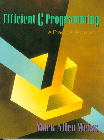 |
Advanced Programming
Spring 2005
Recitation 6: Strings and Pointers
Week 6: Feb 22-24
Due (on time): 2005-03-01 23:59:59
Due (late): 2005-03-06 23:59:59
|
CS 2213/2211 Advanced Programming Spring 2005 Recitation 6: Strings and Pointers Week 6: Feb 22-24 Due (on time): 2005-03-01 23:59:59 Due (late): 2005-03-06 23:59:59 |
Recitation 6 should be submitted
following directions at: submissions with deadlines
|
First refer to the page String Functions for important help with this recitation. This page presents several string functions to use in the recitation and for study.
|
Contents of email submission
for Recitation 6: Last Name, First Name; Course Number; Recitation Number. a. A program for item 1 above, along with the output of a run. Note that you should be testing both reverse functions. b. A probram for items 2-8 above, along with the output of a run. This run should include all the test data for Recitation 3: palindata.txt.
|